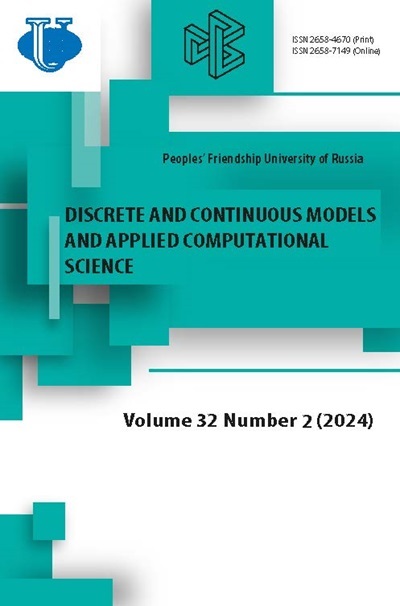Алгоритмы решения краевых задач для атомных тримеров в коллинеарной конфигурации методом Канторовича
- Авторы: Гусев А.А.1, Чулуунбаатар О.1, Виницкий С.И.1, Дербов В.Л.2
-
Учреждения:
- Объединённый институт ядерных исследований
- Саратовский государственный университет
- Выпуск: № 4 (2016)
- Страницы: 56-76
- Раздел: Статьи
- URL: https://journals.rudn.ru/miph/article/view/14561
Цитировать
Полный текст
Аннотация
Ключевые слова
Об авторах
Александр Александрович Гусев
Объединённый институт ядерных исследований
Email: gooseff@jinr.ru
Дубна, Россия
Очбадрах Чулуунбаатар
Объединённый институт ядерных исследований
Email: chuka@jinr.ru
Институт математики, Монгольский государственный университет, Улан-Батор, Монголия Дубна, Россия
Сергей Ильич Виницкий
Объединённый институт ядерных исследований
Email: vinitsky@theor.jinr.ru
Российский университет дружбы народов, Москва, Россия Дубна, Россия
Владимир Леонардович Дербов
Саратовский государственный университет
Email: derbov@sgu.ru
Саратов, Россия
Список литературы
- Efimov V. Few-Body Physics: Giant Trimers True to Scale // Nature Phys. 2009. Vol. 5. Pp. 533-534.
- Observation of an Efimov Spectrum in an Atomic System / M. Zaccanti, B. Deissler, C. D’Errico, M. Fattori, Jona-Lasinio, S. M. Muller, G. Roati, M. Inguscio, M. G. // Nature Phys. 2009. Vol. 5. Pp. 586-591.
- Voigtsberger J. et al. Imaging the Structure of the Trimer Systems 4He3 and 3He4He2 // Nature Commun. 2014. Vol. 5. P. 5765.
- ODPEVP: A Program for Computing Eigenvalues and Eigenfunctions and Their First Derivatives with Respect to the Parameter of the Parametric Self-Adjoined Sturm- Liouville Problem / O. Chuluunbaatar, A.A. Gusev, S.I. Vinitsky, A.G. Abrashkevich // Computer Physics Communications. 2009. Vol. 180. Pp. 1358-1375.
- POTHEA: A Program for Computing Eigenvalues and Eigenfunctions and Their First Derivatives with Respect to the Parameter of the Parametric Self-Adjoined 2D Elliptic Partial Differential Equation / A.A. Gusev, O. Chuluunbaatar, S.I. Vinitsky, G. Abrashkevich // Comput. Phys. Commun. 2014. Vol. 185. Pp. 2636- 2654.
- Описание программы вычисления собственных значений и собственных функций и их первых производных по параметру для параметрической самосопряжённой системы эллиптических дифференциальных уравнений / А.А. Гусев, О. Чулуунбаатар, С.И. Виницкий, А.Г. Абрашкевич // Вестник РУДН, серия «Математика. Информатика. Физика». 2014. № 2. С. 336-341.
- KANTBP: A Program for Computing Energy Levels, Reaction Matrix and Radial Wave Functions in the Coupled-Channel Hyperspherical Adiabatic Approach / O. Chuluunbaatar, A. Gusev, A.G. Abrashkevich, A. Amaya-Tapia, M. Kaschiev, S. Larsen, S. Vinitsky // Comput. Phys. Commun. 2007. Vol. 177. Pp. 649-675.
- KANTBP 2.0: New Version of a Program for Computing Energy Levels, Reaction Matrix and Radial Wave Functions in the Coupled-Channel Hyperspherical Adiabatic Approach / O. Chuluunbaatar, A.A. Gusev, S.I. Vinitsky, A.G. Abrashkevich // Comput. Phys. Commun. 2008. Vol. 179. Pp. 685-693.
- Gusev A. A., Hai L. L., Chuluunbaatar O., Vinitsky S. I. Program KANTBP 4M for Solving Boundary-Value Problems for Systems of Ordinary Differential Equations of the Second Order. - http://wwwinfo.jinr.ru/programs/jinrlib/kantbp4m.
- Symbolic Numerical Algorithm for Solving Quantum Tunneling Problem of a Diatomic Molecule Through Repulsive Barriers / S.I. Vinitsky, A.A. Gusev, O. Chuluunbaatar, L.L. Hai, V.L. Derbov, P.M. Krassovitskiy, A. Go´´zd´z // Lect. Notes Comp. Sci. 2014. Vol. 8660. Pp. 472-490.
- Krassovitskiy P., Pen’kov F. Contribution of Resonance Tunneling of Molecule to Physical Observables // J. Phys. B. 2014. Vol. 47. P. 225210.
- Wang J., Wang G., Zhao J. Density Functional Study of Beryllium Clusters with Gradient Correction // J. Phys. Cond. Matt. 2001. Vol. 13. Pp. L753-L758.
- Стренг Г., Фикс Г. Теория метода конечных элементов. - Москва: Мир, 1977.
- Бате К., Вилсон Е. Численные методы анализа и метод конечных элементов. Москва: Стройиздат, 1982.
- Березин И.С., Жидков Н.П. Методы вычислений. - М.: Физматлит, 1962. Т. 1.
- Гусев А.А., Хай Л.Л. Алгоритм решения двумерной краевой задачи для модели квантового туннелирования двухатомной молекулы через отталкивающие барьеры // Вестник РУДН, серия «Математика. Информатика. Физика». 2015. № 1. С. 15-36.
- Pijper E., Fasolino A. Quantum Surface Diffusion of Vibrationally Excited Molecular Dimers // J. Chem. Phys. 2007. Vol. 126. P. 014708.
- Модели резонансного туннелирования составных систем через отталкивающие барьеры / А.А. Гусев, А. Гоздз, В.Л. Дербов, С.И. Виницкий, О. Чулуунбаатар, П М. Красовицкий // Новости ОИЯИ. 2014. № 1. С. 22-26.
- Mitin A. V. Ab Initio Calculations of Weakly Bonded He2 and Be2 Molecules by MRCI Method with Pseudo-Natural Molecular Orbitals // Int. J. Quantum Chem. 2011. Vol. 111. Pp. 2560-2567.
- Merritt J. M., Bondybey V. E., Heaven M. C. Beryllium Dimer-Caught in the Act of Bonding // Science. 2009. Vol. 324. Pp. 1548-1551.
- Patkowski K., Sˇpirko V., Szalewicz K. On the Elusive Twelfth Vibrational State of Beryllium Dimer // Science. 2009. Vol. 326. Pp. 1382-1384.















